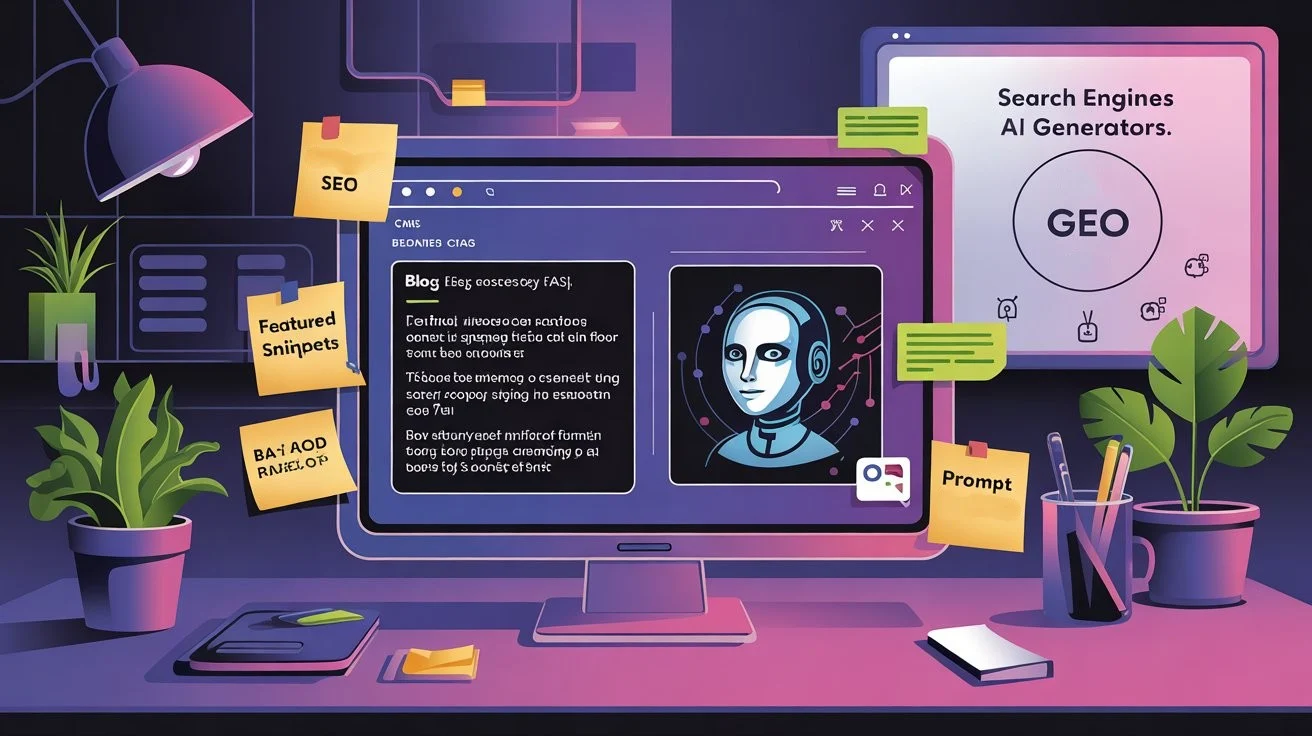Are you ready to learn about generative engine optimization? It’s changing how businesses reach their audience online. This new method is a big change from old SEO ways.
I’m excited to share how GEO is changing digital marketing. It’s not just about ranking high. It makes your content the go-to source for AI answers.
The future of search is here, and it’s AI-powered. Studies show businesses can see up to a 40% boost in visibility with GEO. This is a huge chance for companies ready to change.

In this guide, I’ll show you how to get good at GEO. You can hire a freelancer or do it yourself. Knowing how SEO AI is different is key for digital success.
Table of Contents
Key Takeaways
- Generative engine optimization focuses on becoming the source AI systems cite, not just ranking high
- GEO can increase visibility in AI-powered search responses by up to 40%
- This approach differs significantly from traditional SEO methods and strategies
- Businesses must adapt their content to work with AI-driven search algorithms
- The future of search is shifting toward generative AI platforms and responses
- Understanding GEO principles is essential for maintaining competitive digital presence
Understanding the Shift from Traditional Search to AI-Powered Engines
We’re seeing a big change in how we search online. Gone are the days of typing keywords and scrolling through endless pages. Now, we use ai-powered search to get quick, direct answers.
This change isn’t just about new tech. It’s about what users expect. People don’t want to click through many links anymore. They want answers right away, without having to visit other sites.
The numbers show this shift is real. Zero-click searches now make up 60% of all searches. This means users often find what they need right on the search page. It’s a big change from the old days when we clicked through many links.
Users also love AI summaries. Around 80% of search users use them at least 40% of the time. This shows they prefer quick, contextual info over traditional search results.
The growth of ai-driven search is impressive. ChatGPT saw a 44% traffic increase in November. Perplexity hit 15 million monthly users. These numbers show how fast people are adopting these new search tools.
| Search Method | User Behavior | Click-Through Rate | Information Quality |
|---|---|---|---|
| Traditional Search Engine | Keywords + Multiple Clicks | 40% | Fragmented |
| AI-Powered Search | Conversational Queries | 60% Zero-Click | Comprehensive |
| Hybrid AI Integration | AI Summaries + Links | 25% | Contextual |
| Voice Search | Natural Language | 15% | Direct Answers |
This shift is big because search engines and ai are working together. Now, we can ask complex questions and get detailed answers. No more lists of links.
This change means users expect better info. They want answers that feel personal and right for their situation.
This move from old search results to AI answers is more than just tech. It’s changing how we find and use information. The future is about platforms that understand us, give us what we need, and make searching easy.
🧠 AI + SEO = GEO — And This Freelancer Is Mastering It for Insane Traffic Gains
What is Generative Engine Optimization and Why It Matters
Artificial intelligence is changing how we search online. Generative engine optimization is now key for content creators. It’s changing how we see digital visibility.
The move to AI search is more than a trend. It’s a big change in how we find and use information. When working with clients, I stress the importance of adapting to this change. Your content strategy must evolve, or risk becoming invisible to the millions of users now relying on AI for answers.
Defining GEO in the Modern Search Landscape
Generative engine optimization means creating content for AI to understand and use. It’s not just about ranking high in search results. It’s about being the top source for AI to reference.
This approach is different from old SEO methods. It’s about being the go-to source for AI. Understanding how AI works is key to success in GEO.
Clarity and context are essential. Your content should give clear, direct answers that AI can trust. It should be structured in a way that makes sense to both humans and machines.

Successful GEO strategies share common traits. They answer specific questions directly. They provide context and details. They also show clear authority and credibility.
Key Differences from Traditional SEO Practices
GEO vs traditional SEO is quite different. Unlike traditional SEO, GEO focuses on content depth and relevance. It’s not just about keywords and links.
Traditional SEO focuses on technical aspects like meta tags and page speed. But in AI search, these are less important. Content comprehensiveness is now key.
I explain the differences to my clients like this:
- Focus shift: From ranking pages to becoming cited sources
- Content approach: From keyword-centric to answer-centric writing
- Success metrics: From click-through rates to citation frequency
- Optimization target: From search algorithms to AI comprehension
Generative engines work differently. Instead of trying to trick algorithms, focus on building real expertise. This changes how we approach content strategy.
Businesses struggling with this change often use old SEO tactics. Traditional SEO practices like keyword stuffing can harm your AI visibility.
“The future belongs to those who can create content that serves both human curiosity and artificial intelligence comprehension.”
This evolution is exciting because it values quality and authenticity. Generative engine optimization rewards real expertise and thorough topic coverage. It’s making the industry better and more valuable.
Businesses that adapt early see great results. They’re not just visible; they’re the top authorities in their fields. This is the competitive advantage that forward-thinking companies are building right now.
How Generative AI Engines Work Differently Than Traditional Search
Looking into generative ai engines, I see a new way of handling information. They don’t just look for keywords like old search systems do. Instead, they get the big picture and give detailed answers based on learning patterns.
These engines see your questions in a new light. Old search engines look for keyword matches. Generative ai engines get what you’re asking and craft answers just for you.

Understanding AI Models and Large Language Models
Large language models are key to today’s search tech. These ai models learn from huge texts, picking up on patterns and context.
They work in two main ways. First, they use their knowledge to make answers. Second, they mix their learning with current search results.
This training lets them grasp language nuances. They spot synonyms, context clues, and implied meanings that old systems miss.
Natural Language Processing vs Keyword Matching
Natural language processing changes how search engines get your questions. They look at sentence structure, intent, and context. This lets them handle conversational questions well.
Old search methods focus on keyword density and exact matches. But with natural language, the ai engine looks at your whole question. This leads to more accurate and helpful answers.
The natural language algorithm checks many things at once. It looks at grammar, meaning, and what you really want. This way, it gives answers that fit the context.
| Traditional Search | Generative AI Engines | Key Advantage |
|---|---|---|
| Keyword matching | Context understanding | Better query interpretation |
| Link-based results | Generated responses | Direct answer provision |
| Static page ranking | Dynamic content synthesis | Personalized information |
| Exact phrase dependency | Natural language flexibility | Conversational interaction |
This new tech lets us ask questions like we talk to people. The generative ai engines get the implied meaning and give answers that really meet our needs.
💥 The Secret Sauce Behind Viral Content? This Freelancer’s GEO Strategy
The Rise of AI Search Platforms and Their Impact
AI search platforms are changing how we find and use information online. The numbers show a fast growth in adoption and a shift in what users want. Millions of people are now using these new ways to search.
This change is more than just new tech. It’s a big shift in how we look for and use information. Now, people prefer talking to a search engine instead of typing keywords.

Revolutionary Platforms Changing Search Behavior
ChatGPT is a big deal in the world of AI search. It has 180.5 million monthly users, showing how much people want to talk to search engines. It’s amazing how fast people got used to asking questions naturally instead of typing keywords.
ChatGPT’s success comes from understanding what you mean and giving clear answers. You don’t have to look through many results anymore. You get straight to the point with the info you need.
Perplexity is another big name in AI search. It has seen an 858% surge in search volume, showing it’s growing fast. What makes Perplexity stand out is its focus on giving accurate, cited info in a way that feels like talking.
Platforms like ChatGPT are setting new standards for search. People want quick, complete answers, not just links to follow. This change is pushing traditional search engines to update or risk being left behind.
Google’s Response to the AI Revolution
Google has introduced AI Overviews, showing they get the shift in user behavior. They aim to reach 1 billion searchers with this feature by the end of the year. This goal shows Google’s commitment to keeping up with the changing search world.
The Search Generative Experience is Google’s way of mixing old search with new AI. I’ve seen how it tries to give quick, AI-made summaries while keeping the search result look we’re used to.
Google’s method is different from platforms like ChatGPT. They’re adding AI to their search tools. This lets them use their huge database while making searches better for users.
The effects of these changes are big. They’re changing what users expect and making all search providers rethink their strategies. The competition to offer the best, most helpful search experience is on.
Step 1: Analyzing Your Current Content for AI Compatibility
Before we dive into advanced GEO strategies, I start by checking how my content works with AI engines. This first step shows which content is good with AI and which needs work.
This analysis helps me see my content’s strengths and weaknesses. I learn how AI systems see and use my content. This is key for a good optimization plan.

Using HubSpot’s AI Search Grader to Evaluate Performance
When I use HubSpot’s AI Search Grader, I get insights on my content’s AI performance. This tool checks many things that affect if AI will show my content.
The ai search grader looks at several important content elements. It checks if my pages answer questions well and if they give AI systems info to summarize.
I’ve noticed that content that ranks well in search often does well with AI too. But, this isn’t always true. The grader shows me which top pages might need AI tweaks.
| Content Element | Traditional SEO Focus | AI Compatibility Factor | Optimization Priority |
|---|---|---|---|
| Answer Quality | Keyword density | Comprehensive responses | High |
| Content Structure | Header hierarchy | Logical information flow | Medium |
| Query Matching | Exact keyword matches | Intent understanding | High |
| Source Authority | Domain authority | Expertise signals | Medium |
This process tells me where to optimize content for AI. It’s based on data, not guesses.
Identifying Content Gaps for Generative Engines
After the initial check, I look for gaps in my content for generative engines. These gaps often show where traditional SEO content doesn’t work for AI.
I’ve found that many pieces lack a conversational tone AI likes. Traditional content can sound robotic when AI tries to make it natural.
Another gap is incomplete answers to questions. While SEO targets keywords, content for AI needs to give full, contextual answers. AI prefers content that answers follow-up questions too.
I also check for missing schema markup and structured data. These help AI systems understand and organize my content better. Without them, even great content might be missed by AI.
This gap analysis shows how to make your content work for both SEO and AI. This approach helps your content be seen on all search platforms.
By doing this detailed analysis, I have a clear plan for improving my content. I know which pieces need work and which are already good with AI. This makes the GEO process more efficient and effective.
🎯 Rank Faster. Write Smarter. Convert Better. This GEO Pro Does It All
Step 2: Optimizing Content Structure for AI Understanding
How I organize my content is key for AI to get it. Unlike old search engines, AI needs clear structure and context. This means I must be both a writer and a data expert when optimizing content for generative engines.
This isn’t just about following technical SEO rules. It’s about making content that flows well and gives AI the context it needs. This way, AI can understand my expertise and authority on a topic.

Creating Clear, Contextual Content Hierarchies
AI engines do best when content flows logically. I start with a clear introduction that sets the context. Then, I break down complex topics into easy-to-digest sections.
My approach includes:
- Descriptive headings that clearly show what each section is about
- Short paragraphs that focus on one concept
- Bullet points and numbered lists for easy scanning
- Summary sections that reinforce main points
When I write, each heading tells a complete story about what’s coming next. Instead of vague titles, I use specific headings like “How Schema Markup Improves AI Content Understanding.” This helps AI engines understand and use my information properly.
Content hierarchy isn’t just about organization—it’s about creating a roadmap for both human readers and AI systems through your expertise.
Implementing Schema Markup for Better AI Comprehension
Schema markup is a powerful tool for AI to understand my content. It acts like a translator, providing clear labels for different types of information.
I focus on these essential schema markup types:
- Article schema for blog posts and guides
- FAQ schema for question-and-answer content
- How-to schema for step-by-step instructions
- Organization schema for business information
Choosing the right schema types is key. For tutorials, I use How-to schema. For informational articles, I use Article schema to help AI understand the topic and expertise level.
These best practices have changed how I create content. Now, I write for both human readers and AI systems. This leads to better user experience and visibility in AI-powered search results.
My optimization strategies include testing AI’s ability to parse my content structure. I regularly check my headings, schema implementation, and content hierarchy. This ensures my content works well for both humans and AI systems.
Step 3: Mastering Natural Language and User Intent
When I optimize content for AI engines, I aim to mimic human conversations. This is a big change from the old days of keyword-focused writing. Natural language optimization means making content that feels natural but also meets search engine needs.
Understanding how people talk to AI systems is key. Unlike old search engines, people now ask AI full questions. They want answers that fully meet their needs.
Creating Content That Matches Real Speech Patterns
I’ve found that conversational content should reflect how we speak. Instead of saying “best pizza restaurant location,” I say “Where can I find the best pizza restaurant near me?” This makes content easier for both AI and humans to understand.
Here are my optimization tips for writing like we talk:
- Use complete sentences that answer specific questions
- Include transition words like “however,” “therefore,” and “additionally”
- Write in active voice whenever possible
- Address the reader directly using “you” and “your”
- Incorporate natural speech patterns and contractions
When doing keyword research for GEO, I look for question-based phrases. Tools like AnswerThePublic show me how people really ask questions. This helps me understand user intent better.
Building Comprehensive Answer Frameworks
Answering user questions fully means thinking about what else they might ask. If someone asks about pizza restaurants, they might also want to know about prices, hours, or special diets. I make sure my content covers these topics naturally.
My method for answering questions fully includes:
- Direct answer to the main question
- Supporting details that add context
- Related information that users often need
- Actionable next steps for the reader
This way, each piece of content is a complete resource. AI engines prefer content that fully answers user needs without needing more searches.
I also focus on the connections between ideas. When I write about a topic, I include related terms and phrases that naturally fit into conversations. This helps AI engines understand the context better than just repeating keywords.
The goal is to create natural language that truly helps users. When content genuinely assists people, it does well in both traditional search results and AI responses.
Step 4: Building Authority and Trust for AI Engines
When working on GEO strategies, building authority is key. AI engines check your credibility with complex algorithms. They look at your expertise, trustworthiness, and influence.
Unlike old search engines, AI systems check many trust indicators at once. They look at how accurate your info is and if other trusted sources mention you. This is both a challenge and an opportunity for content creators.

Being in ai search results means AI trusts you. When AI recommends your content, it shares its own authority with you. This makes the process more strict but rewarding.
Establishing Yourself as a Trusted Source
To win AI trust, show real expertise. AI systems can tell if your content is deep or just superficial. They check your content’s depth, accuracy, and consistency.
The E-E-A-T principles are more important now. AI checks your claims against real facts. If your info is wrong or lacks evidence, AI will lower your credibility.
“Trust is built with consistency. You can be flawed and make mistakes, but you can’t fake caring about something.”
— Seth Godin
To be seen as a trusted source, focus on these strategies:
- Demonstrate real experience: Share specific examples and personal insights
- Maintain factual accuracy: Double-check all stats and quotes before publishing
- Show your credentials: Include author bios and qualifications
- Update content regularly: Keep your info current and relevant
AI engines value content that shows humility and honesty. They reward balanced perspectives over confident claims.
Leveraging Backlinks and Citations Effectively
Backlinks and AI engines have a different relationship than traditional SEO. AI focuses on link relevance and authority. A single link from a respected source can be more valuable than many generic links.
Quality citations are key for AI. They show your connection to the broader knowledge ecosystem. This supports your arguments and shows your expertise.
| Traditional SEO Authority Factors | AI Engine Authority Factors | Impact Level |
|---|---|---|
| Link quantity and domain authority | Source relevance and expertise alignment | High |
| Anchor text optimization | Contextual relationship quality | Medium |
| Link velocity and patterns | Citation accuracy and freshness | High |
| Domain age and history | Content consistency and expertise depth | Very High |
Building backlinks for AI engines requires these strategies:
- Target industry publications: Get mentioned in trade publications and blogs
- Create linkable assets: Develop original research and guides
- Engage in expert roundups: Show your expertise in industry discussions
- Guest posting with purpose: Write for publications where your audience reads
AI engines understand link context better. They see why a link exists and if it supports your authority.
Citations need even more attention. AI can verify sources instantly. Make sure:
- All citations link to the original source
- Quoted material is accurate and attributed
- Statistical claims include dates and methodology
- Sources match the topic’s expertise level
AI engines evaluate your overall digital presence. Consistency across all content builds your authority. This requires a long-term commitment to quality and expertise.
Investing in authority pays off when AI features your content. This visibility can influence generative ai across platforms. This effect is rare in traditional SEO.
👀 Traditional SEO Is Fading. This GEO Freelancer Is the New Traffic Magnet
Technical SEO Considerations for Generative Engines
Your website’s technical aspects greatly affect how AI engines find and process your content. While content quality is key, technical SEO is the base for success in generative optimization.
When helping clients move to GEO strategies, I start with the basics. AI search engines need websites that are clean and easy to access. Without a strong technical base, even the best content can be missed.
“Technical SEO is like the foundation of a house – you might not see it, but everything else depends on it being solid.”

Site Performance and AI Crawling
How fast your site loads affects AI search engines’ interaction with your content. I’ve seen that page load speeds under three seconds are critical for AI crawling. Slow sites block AI engines from efficiently processing your content.
AI crawling is different from traditional search engine crawling. These systems analyze and understand content context, not just keywords. They need more power and time per page visit.
Here are the key performance factors I focus on:
- Core Web Vitals optimization for faster loading
- Clean HTML structure that AI can easily parse
- Minimized JavaScript that might block content access
- Optimized images and media files
- Reliable hosting with consistent uptime
Remember, AI systems are sophisticated computer programs. They need websites that load quickly and consistently to work best.
Mobile Optimization for AI-Driven Search
Mobile optimization is now more important than ever with AI-driven search engines. Many users use mobile devices to interact with AI search tools. Responsive design is essential.
I’ve seen that AI search engines focus on mobile user experience when judging content quality. A website that doesn’t work well on mobile devices is seen as low quality, even with excellent content.
My mobile optimization checklist includes:
- Responsive design that adapts to all screen sizes
- Touch-friendly navigation and buttons
- Fast mobile loading speeds
- Readable text without zooming
- Optimized mobile search functionality
The link between technical SEO and search engine results is stronger than ever. AI systems use technical signals to judge content accessibility and quality. When auditing websites for GEO readiness, technical issues often explain why great content isn’t seen in AI responses.
Mobile optimization also impacts how AI engines understand user intent. Mobile searches often have different contexts than desktop searches. AI systems need websites that deliver great mobile experiences to meet user needs.
Technical foundations are key for generative engine optimization. Without proper site performance and mobile optimization, your content strategy and authority building won’t reach their full AI-driven search environment.
Measuring Success in the GEO Era
Old metrics don’t tell the whole story of SEO success anymore. Click-through rates and rankings are important, but they miss the mark when it comes to AI-generated content. I’ve learned that success in generative engine optimization needs a fresh perspective.
Understanding how users interact with AI search platforms is key. When someone asks ChatGPT or Perplexity a question, they might find valuable info from my content without visiting my site. This change means I must track different signs of success.
“Success in the age of AI search isn’t just about traffic—it’s about becoming the trusted source that AI engines cite and recommend.”
Beyond Traditional Rankings
I’ve had to expand my toolkit to measure success. Brand mentions and citations in AI results are now key indicators. When my expertise is referenced in AI responses, it boosts my authority, even without direct website visits.
Engagement now includes tracking my content’s appearance in AI responses. I also watch social media mentions from AI content recommendations. These new metrics show my true visibility in the changing search world.
Authority signals are more important than ever. When AI engines consistently cite my work, it shows trust and credibility. I track these citations across various platforms to see my content’s influence in AI responses.
Tracking AI Search Visibility
Tracking visibility in AI search results needs special tools and methods. I test my content’s appearance in AI platforms by asking questions. This hands-on approach shows how different engines present my info.
I’ve developed a method to track mentions across ChatGPT, Perplexity, and other AI platforms. By searching for my brand name and key topics, I see how often my content is referenced. This data shows which topics AI algorithms find most relevant.
Measuring across multiple platforms is vital. Each AI engine has its own preferences and algorithms. What works on one might not on another. I track performance across various engines to understand my content’s reach.
The key is to mix old SEO metrics with new indicators. While website traffic is important, AI citations build long-term brand recognition and authority. This balanced approach gives a complete view of my content’s impact in today’s search world.
🛠️ Want AI-Generated, SEO-Optimized, Rank-Boosting Content? Hire This Pro!
Common Mistakes to Avoid When Transitioning to GEO
Many businesses make big mistakes when they start using generative engine optimization. I’ve seen companies jump into AI optimization without a plan. This rush often leads to bad results and wasted money.
The key to doing well with GEO is knowing what not to do. Smart businesses learn from others’ mistakes. Here are the most common mistakes I’ve seen during GEO transitions.
Over-Optimization Pitfalls
Over-optimization is a big threat to your GEO success. I’ve seen businesses try to trick AI systems with manipulative tactics. These tricks usually backfire.
AI engines are smart and can spot unnatural content. Stuffing keywords or making content just for algorithms can get you in trouble. Quality is more important than quantity in the AI world.
Unlike old search engines, AI looks at context and meaning deeply. They know when content feels fake. I suggest focusing on natural language that meets real user needs.
Common over-optimization mistakes include:
- Keyword stuffing to trick AI
- Making the same content for different AI platforms
- Changing schema markup to fool AI crawlers
- Creating low-quality content for AI visibility
Neglecting Traditional SEO Best Practices
Another big mistake is ignoring traditional SEO. I’ve seen businesses switch to GEO without keeping up with proven SEO methods. This leaves gaps in your strategies.
Traditional SEO and GEO work best together. Your website needs a solid foundation. Search engine results pages are important for visibility.
Important traditional elements include:
- Page load speed and mobile responsiveness
- Proper URL structure and internal linking
- Meta descriptions and title tag optimization
- High-quality backlink profiles
I always tell my clients to keep up with SEO best practices while adding GEO elements. This balanced approach helps avoid algorithm changes. It also keeps performance steady across all search platforms.
| Mistake Type | Impact Level | Recovery Time | Prevention Strategy |
|---|---|---|---|
| Keyword Stuffing | High | 3-6 months | Natural language focus |
| Ignoring Technical SEO | Medium | 1-3 months | Maintain core foundations |
| Poor Content Quality | High | 6-12 months | User-first content creation |
| Neglecting Mobile Optimization | Medium | 2-4 months | Responsive design priority |
Remember, successful GEO implementation takes time and strategy. Avoid shortcuts that promise quick results. Instead, focus on building sustainable optimization practices that work for both AI engines and human users.
Getting Professional Help for Your Generative Engine Optimization Strategy
Many businesses face challenges with generative AI platforms. The fast pace of artificial intelligence makes it hard to keep up. A good GEO strategy needs time and special knowledge.
The generative AI tools learning curve is steep. Business owners get overwhelmed by the tech needs. Measurement complexity makes things even harder.
- Understanding how different AI platforms prioritize content
- Keeping up with technology updates
- Measuring success with new metrics and analytics
- Managing GEO with other marketing tasks
- Avoiding costly mistakes during implementation
Professional help is key in dealing with these issues. An expert can guide you through each AI tool and platform. They know which content formats work best.
Having a specialist allows generative optimization to fit your business needs. They pick the best generative AI tools for your industry. This saves time and money.
The benefits of expert guidance include:
- Customized strategy development based on your goals
- Fast implementation without trial-and-error delays
- Access to the latest optimization techniques
- Ongoing support as AI technology evolves
- Performance monitoring and strategy adjustments
If you need help with GEO, hire a skilled freelancer in generative engine optimization. They’ll create a strategy tailored for your business. This investment can lead to better visibility and results.
Professional help in using generative optimization maximizes your efforts. Experts help you avoid mistakes and stay competitive. The right specialist can change how you use AI for search optimization.
Think of professional help as an investment in your digital future. Working with a GEO specialist will benefit your business in the long run. This knowledge becomes more valuable as AI changes search landscapes.
Conclusion
We are at a critical point in digital marketing history. The power of generative ai is changing how we find things online. It’s the biggest change in search history, even bigger than Google’s impact.
My research and experience show that generative ai search gives us more personalized results. This change means businesses need to update their strategies to stay ahead.
The main thing to remember is that generative engines value content that truly helps users. Your goal should be to create content that answers real questions. This is different from traditional SEO.
I urge you to start using these strategies right away. Begin by analyzing your content and then add fluency optimization. The companies that get good at this now will lead the search world later.
The future is for those who get this technology. By using the strategies I’ve shared, you’re setting yourself up for success in the generative search era. It’s time to take action.
📊 Still Using Old SEO Tactics? Time to Upgrade to GEO — Here’s Who Can Help
Frequently Asked Questions
Got more questions about What is Generative Engine Optimization (GEO): Your SEO Future? I’m here to help! I’ve gathered some of the most common inquiries to provide you with quick and clear answers.
Q: What is the perplexity of Generative Engine Optimization compared to traditional SEO?
A: Generative Engine Optimization (GEO) represents a more complex optimization landscape than traditional search engine optimization. While traditional SEO focuses on ranking web pages, GEO deals with optimizing content to be selected, synthesized, and presented within AI-generated responses. The perplexity comes from how generative search engines evaluate content based on accuracy, relevance, and usefulness rather than just keywords and backlinks. Unlike traditional search engines that simply rank existing content, generative AI search engines create new content from multiple sources, making the optimization process more sophisticated and multidimensional.
Q: What optimization tips should I follow for Generative Engine Optimization?
A: To optimize for generative engines, focus on creating comprehensive, factual content that directly answers user queries with depth and authority. Ensure your content includes clear headers, structured data, and concise summaries that generative AI can easily extract. Use natural language that matches how people ask questions conversationally. Develop content that covers topics thoroughly from multiple angles, as generative engines prioritize content that provides complete information. Additionally, maintain high E-E-A-T (Experience, Expertise, Authoritativeness, Trustworthiness) standards, as AI platforms like ChatGPT and generative search engines tend to favor credible sources when generating responses.
Q: How is GEO different from SEO in practice?
A: GEO differs from SEO in several fundamental ways. While traditional search engine optimization focuses on ranking pages in search results, GEO aims to get your content included in AI-generated answers. SEO typically rewards keyword optimization and backlink building, whereas GEO rewards factual accuracy, comprehensive information, and direct answers to questions. With SEO, success means visibility in traditional search engine results pages; with GEO, success means having your content synthesized into generative engine responses. SEO drives traffic to your website, while GEO might extract your information without sending users to your site, creating new challenges for content creators.
Q: How will Generative Engine Optimization impact search engine results?
A: Generative Engine Optimization will fundamentally transform search results by shifting from lists of links to direct, synthesized answers. Users will increasingly receive comprehensive responses compiled from multiple sources rather than clicking through to websites. This change will decrease traditional website traffic patterns while elevating the importance of being included as a source in AI-generated answers. According to Search Engine Land and other industry experts, websites that adapt to GEO practices will maintain visibility, while those optimizing solely for traditional search engine formats may see declining traffic as generative AI search results become more prevalent.
Q: What does the future of search look like with Generative Engine Optimization?
A: The future of search with GEO points toward conversational, contextual, and continuously evolving interactions. Search will become more like having a knowledgeable assistant than scanning through links. We’ll likely see a hybrid model where traditional search results coexist with generative AI results, with the latter gradually gaining prominence. Content creators will need to adapt by focusing on providing genuine value, demonstrating expertise, and structuring information to be AI-friendly. As search engines like Google continue developing their Search Generative Experience and similar platforms evolve, the line between searching for information and having a conversation will increasingly blur.
Q: How do generative engines work differently from traditional search engines?
A: Generative engines work by retrieving relevant information from across the web and then synthesizing it into new, coherent responses, unlike traditional search engines that simply rank and display existing content. They employ large language models to understand user queries contextually and generate human-like responses based on the information they’ve processed. While traditional search engines match keywords to webpages, generative AI search engines interpret the intent behind queries and create custom answers. Additionally, generative engines can maintain conversation context over multiple interactions, allowing for follow-up questions and more natural information discovery experiences that traditional search engine results pages cannot provide.
Q: How can businesses use generative AI to improve their search visibility?
A: Businesses can use generative AI to improve search visibility by first understanding how these systems evaluate and extract information. Create content that directly answers common questions in your industry with clear, factual information. Develop comprehensive resources that demonstrate expertise and authority. Structure your content with clear headings, bullet points, and summaries that generative AI can easily parse. Consider creating specialized content formats like FAQ pages, how-to guides, and definitive explanations that align with how people use generative search engines. Additionally, maintain regular content updates to ensure accuracy, as generative engines prioritize content that remains current and trustworthy in their responses.
Q: What impact will Google’s Search Generative Experience have on GEO?
A: Google’s Search Generative Experience will significantly accelerate the importance of Generative Engine Optimization as it represents the most mainstream integration of generative AI into search. As this feature moves from experimental to standard, websites will need to adapt their content strategies to remain visible in these AI-generated responses. The Search Generative Experience will likely establish new optimization benchmarks and best practices for GEO. Content creators who understand how to optimize for both traditional search engine results and generative AI results will maintain visibility across both formats. As Google refines this technology, expect rapid evolution in how content is evaluated, synthesized, and presented, making adaptive GEO strategies essential for continued search visibility.
Q: GEO vs traditional SEO: Which should I prioritize for my website?
A: Rather than choosing between GEO vs traditional SEO, the most effective approach is integrating both strategies. Start by maintaining solid SEO fundamentals like technical optimization, quality backlinks, and keyword research, as these will remain valuable for traditional search engine formats. Then layer in GEO practices by creating comprehensive, factually accurate content that directly answers user questions in conversational language. Focus on demonstrating expertise and structuring content to be easily parsed by AI systems. The websites that will thrive in this transition period are those that can satisfy both algorithms and human readers while providing genuine value. As generative search becomes more prominent, gradually shift more resources toward GEO while maintaining SEO basics.
Related Articles:
- SEO: How Important is Search Engine Optimization?
- Why is Search Engine Marketing Important? : Essential Benefits & Winning Strategies
- Local Search Engine Optimization Guide: Improve Your Local SEO Ranking
- eCommerce SEO Service: Your Top eCommerce SEO Agency for Online Retailers
- Video SEO Service: YouTube Search Engine Optimization, Boost Your Online Visibility
This post contains affiliate links, which means I may earn a commission if you make a purchase through these links. There is no additional charge to you! Thank you for supporting my blog so I can continue creating free content each week!





